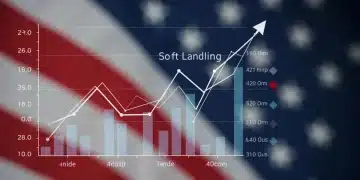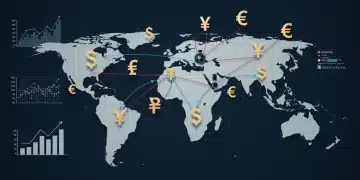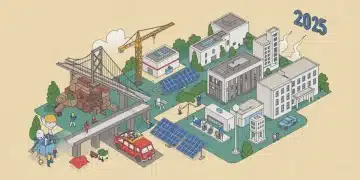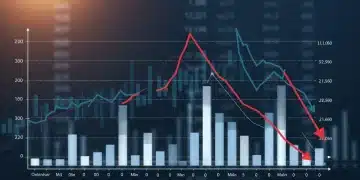2025 Economic Outlook: Inflation & Unemployment Trends Explored
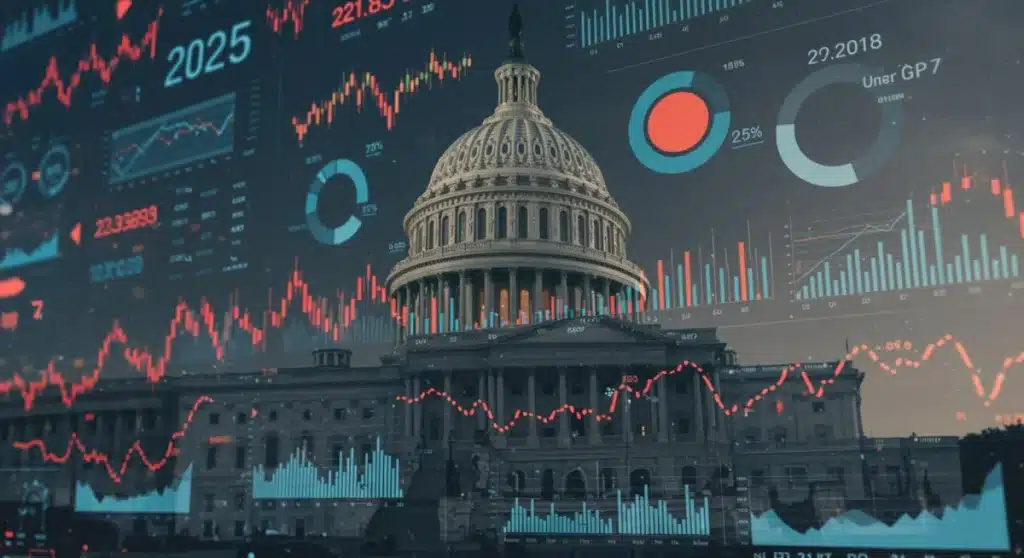
The 2025 economic outlook forecasts a period of careful balancing acts between controlling inflation and maintaining robust employment, influenced by global dynamics and domestic policy shifts.
As we navigate the complexities of the post-pandemic era, understanding the 2025 economic outlook: expert analysis on inflation and unemployment trends becomes paramount for individuals, businesses, and policymakers alike. What factors will shape the financial landscape, and how might these influence our daily lives? This comprehensive analysis delves into the anticipated economic shifts, offering insights into what lies ahead.
Understanding the Current Economic Landscape
Before peering into 2025, it’s crucial to grasp the foundational elements currently shaping the US economy. The past few years have been characterized by unprecedented volatility, driven by supply chain disruptions, geopolitical tensions, and significant shifts in consumer behavior. These factors have created a challenging environment for central banks attempting to manage inflation while fostering sustainable growth.
The Federal Reserve, in particular, has been at the forefront of these efforts, employing various monetary policy tools to cool down an overheating economy without triggering a severe recession. Their dual mandate of maximum employment and price stability remains a delicate balancing act, with every decision having far-reaching implications across different sectors.
Key Economic Indicators in Focus
Several indicators provide a snapshot of the economy’s health, and their current trajectories offer clues for the future. Gross Domestic Product (GDP) growth, consumer spending, and business investment figures are all closely watched. These metrics help economists gauge the overall momentum and resilience of the economy.
- GDP Growth: Reflects the total economic output, indicating expansion or contraction.
- Consumer Spending: A major driver of the US economy, influenced by confidence and disposable income.
- Business Investment: Signals future economic activity and job creation.
- Trade Balances: Impacts domestic production and international economic relations.
The interplay of these indicators paints a complex picture, suggesting an economy that is both resilient in some areas and vulnerable in others. Understanding these current conditions is the first step in formulating an informed perspective on the economic prospects for 2025.
Inflationary Pressures: A Look Ahead to 2025
Inflation has been a dominant theme in recent economic discussions, impacting everything from grocery prices to housing costs. As we approach 2025, the trajectory of inflation remains a critical concern for economists and the public alike. Will the measures taken so far be sufficient to bring price increases back to target levels, or are there persistent underlying factors that will continue to fuel inflation?
Expert analysis suggests a gradual moderation of inflation, though the path is unlikely to be smooth. Supply chain improvements, easing energy prices, and the lagged effects of monetary policy tightening are expected to contribute to this deceleration. However, potential new shocks, such as geopolitical events or unexpected commodity price spikes, could derail these projections.
Factors Influencing Inflation in 2025
Several key factors will play a pivotal role in determining inflation levels next year. Understanding these influences is essential for anticipating the future economic climate. Labor market dynamics, for instance, can significantly impact wage growth, which in turn affects production costs and consumer prices.
- Wage Growth: Strong wage growth can lead to higher consumer demand and increased production costs, fueling inflation.
- Supply Chain Resilience: Improved logistics and reduced bottlenecks can alleviate price pressures.
- Energy Prices: Global oil and gas markets remain volatile, with significant implications for inflation.
- Geopolitical Stability: Conflicts and trade disputes can disrupt supply and demand, leading to price volatility.
- Fiscal Policy: Government spending and taxation policies can either stimulate or dampen inflationary pressures.
The consensus among many economists is that while inflation will likely cool, it may not return to the pre-pandemic 2% target as quickly as some hope. This persistent level of inflation would require continued vigilance from the Federal Reserve and could influence consumer purchasing power and investment decisions throughout 2025.
Unemployment Trends and the Labor Market
The labor market has shown remarkable resilience in recent years, often defying expectations of slowdowns despite aggressive interest rate hikes. As we look towards 2025, forecasting unemployment trends involves carefully weighing ongoing economic adjustments against underlying demographic shifts and technological advancements. The goal is to achieve a soft landing where inflation is controlled without a significant rise in job losses.
Many experts predict a slight softening of the labor market in 2025, which would be a natural consequence of efforts to cool the economy. However, a widespread surge in unemployment is generally not anticipated. Instead, a more balanced labor market, where job openings align more closely with the number of job seekers, is the expected outcome. This rebalancing could alleviate some wage pressures, contributing to broader inflation control.

Key Drivers of Unemployment in 2025
Several factors will shape the unemployment landscape in the coming year. These include the pace of economic growth, technological adoption, and the ongoing evolution of work patterns. Understanding these drivers helps to paint a clearer picture of potential challenges and opportunities for job seekers and employers.
- Economic Growth Rate: Slower growth typically corresponds to higher unemployment, while robust growth supports job creation.
- Technological Advancements: Automation and AI could displace some jobs while creating new ones, leading to shifts in labor demand.
- Sectoral Shifts: Changes in consumer preferences and industry trends can lead to job gains in some sectors and losses in others.
- Demographic Changes: Aging populations and changes in labor force participation rates influence overall employment levels.
- Monetary Policy Impact: Higher interest rates can slow business expansion, potentially affecting hiring decisions.
The labor market in 2025 is expected to remain tight by historical standards, but with less intense competition for workers than seen in previous years. This could lead to a more sustainable wage growth trajectory and a more stable employment environment overall, which is a key component of a successful 2025 economic outlook.
Monetary Policy and Federal Reserve Actions
The Federal Reserve’s role in shaping the 2025 economic outlook cannot be overstated. Its primary tools—interest rates and quantitative easing/tightening—directly influence borrowing costs, investment, and consumer spending. The decisions made by the Federal Open Market Committee (FOMC) will be critical in navigating the dual challenges of inflation and unemployment.
As we head into 2025, the Fed is expected to continue its data-dependent approach, carefully monitoring economic indicators before making policy adjustments. The central bank’s communication strategy will also be vital, as clear guidance can help manage market expectations and prevent unnecessary volatility. Any deviations from expected policy paths could have significant impacts on financial markets and the broader economy.
Anticipated Fed Strategies for 2025
Forecasting the Fed’s exact moves is challenging, but general strategies can be anticipated based on current economic conditions and historical patterns. The emphasis will likely remain on achieving price stability while avoiding a deep recession. This involves a delicate balance of maintaining restrictive monetary policy until inflation is firmly under control, without stifling economic activity too severely.
- Interest Rate Adjustments: The Fed may consider further rate hikes if inflation proves more persistent, or cuts if economic growth significantly weakens.
- Quantitative Tightening: Continuing to reduce the Fed’s balance sheet will remove liquidity from the financial system, further tightening monetary conditions.
- Forward Guidance: Clear communication about future policy intentions will be crucial for market stability.
- Inflation Target Adherence: The Fed’s commitment to its 2% inflation target will guide its policy decisions.
The effectiveness of the Fed’s policies in 2025 will largely depend on the responsiveness of inflation and unemployment to these measures. A successful outcome would involve a gradual return to price stability with minimal disruption to the labor market, a scenario that would greatly bolster the overall economic health.
Global Economic Influences on the US in 2025
The US economy does not operate in isolation; it is deeply intertwined with global economic trends, geopolitical events, and international trade dynamics. As we project into 2025, understanding these external influences is essential for a comprehensive economic outlook. Shocks from abroad, whether economic or political, can quickly reverberate through the domestic market, affecting everything from supply chains to investor confidence.
Key global factors include the economic performance of major trading partners, commodity prices, and the stability of international financial markets. For instance, a slowdown in China or Europe could reduce demand for US exports, while fluctuations in global oil prices can directly impact domestic inflation and consumer spending. Geopolitical tensions, such as ongoing conflicts or trade disputes, also introduce significant uncertainty and risk.
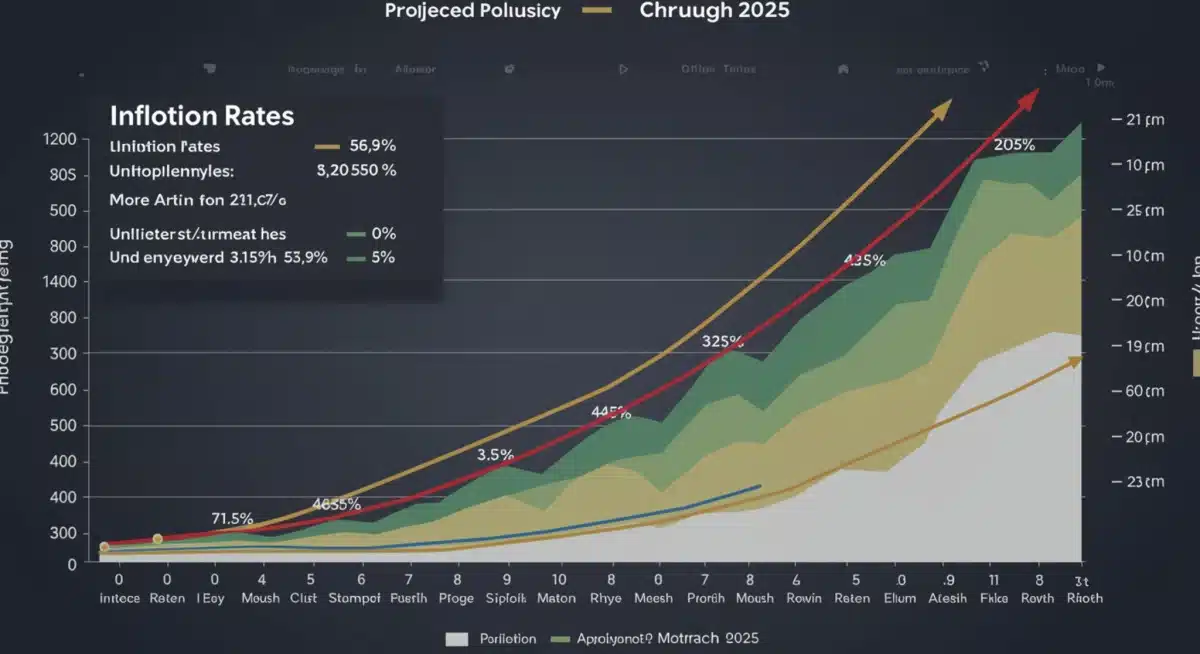
Major Global Factors to Watch
Several international developments will warrant close attention in 2025, as they hold the potential to significantly impact the US economic landscape. These factors are diverse, ranging from economic policies in other nations to broader geopolitical shifts.
- China’s Economic Trajectory: Its growth and stability impact global supply chains and demand for commodities.
- European Economic Health: Recessions or strong growth in Europe can affect US trade and investment.
- Commodity Market Volatility: Prices of oil, gas, and agricultural products are influenced by global supply and demand, and geopolitical events.
- Geopolitical Risks: Conflicts and political instability in key regions can disrupt trade routes and create economic uncertainty.
- Global Interest Rate Environment: Policies of other major central banks can influence capital flows and currency valuations.
The interconnectedness of the global economy means that the US will need to remain agile in its economic policies, ready to adapt to external shocks and leverage international opportunities. A robust global economy generally provides a more favorable environment for US growth and stability.
Sector-Specific Forecasts and Investment Implications
While the overall 2025 economic outlook provides a broad picture, a deeper dive into specific sectors reveals varied prospects and potential investment implications. Different industries respond uniquely to inflation, interest rates, and consumer spending patterns. Understanding these nuances is crucial for businesses making strategic decisions and for investors seeking optimal returns.
Sectors like technology, healthcare, and renewable energy are often seen as having strong long-term growth potential, driven by innovation and demographic shifts. Conversely, sectors heavily reliant on consumer discretionary spending or sensitive to interest rate changes, such as real estate and certain retail segments, might face more headwinds. The labor market dynamics within each sector will also play a crucial role, influencing wage pressures and hiring challenges.
Key Sectors to Watch in 2025
Several sectors are anticipated to experience significant developments in 2025, offering both challenges and opportunities. These predictions are based on current trends, technological advancements, and shifts in consumer and business demand.
- Technology: Continued growth in AI, cloud computing, and cybersecurity, but potentially facing regulatory scrutiny.
- Healthcare: Driven by an aging population and advancements in medical technology, maintaining strong demand.
- Renewable Energy: Benefiting from government incentives and increasing global commitment to sustainability.
- Manufacturing: Potential for reshoring and automation to boost efficiency, but sensitive to global supply chain issues.
- Financial Services: Adapting to evolving regulatory landscapes and technological disruption, while navigating interest rate environments.
Investors should carefully consider these sector-specific forecasts when constructing portfolios, balancing growth opportunities with potential risks. Businesses, too, must adapt their strategies to capitalize on emerging trends and mitigate challenges specific to their industries, ensuring resilience in a dynamic economic environment.
Navigating the 2025 Economic Landscape
The 2025 economic outlook presents a complex but not insurmountable set of challenges and opportunities. For individuals, understanding these trends means making informed decisions about personal finance, career planning, and consumption. For businesses, it involves strategic planning, risk management, and identifying growth areas. Policymakers, meanwhile, will continue to fine-tune monetary and fiscal strategies to maintain stability and foster prosperity.
One of the most important takeaways is the need for adaptability. The economy is a dynamic system, and unforeseen events can quickly alter projections. Therefore, a flexible approach that allows for adjustments based on new data and evolving circumstances will be key to successfully navigating the year ahead. Economic resilience will be tested, but also strengthened through these adaptive measures.
Strategies for Resilience and Growth
Both individuals and organizations can adopt strategies to enhance their resilience and position themselves for growth in 2025. These strategies often involve a combination of prudent financial management, continuous learning, and strategic investment.
- For Individuals: Focus on building emergency savings, diversifying investments, and enhancing skills to remain competitive in the labor market.
- For Businesses: Prioritize supply chain diversification, invest in technology for efficiency, and maintain strong balance sheets to weather economic fluctuations.
- For Policymakers: Continue data-driven decision-making, maintain transparent communication, and foster international cooperation to address global economic challenges.
Ultimately, the 2025 economic landscape will be shaped by a multitude of interconnected factors. While inflation and unemployment trends will remain central, the ability to adapt, innovate, and collaborate will determine the overall success of the US economy. Vigilance and informed decision-making will be critical in harnessing opportunities and mitigating risks in the coming year.
| Key Economic Aspect | Brief 2025 Outlook |
|---|---|
| Inflation | Expected to moderate gradually but may remain above the Fed’s 2% target. |
| Unemployment | Anticipated to soften slightly, rebalancing the labor market without a significant surge. |
| Monetary Policy | Federal Reserve to maintain a data-dependent approach, focusing on price stability. |
| Global Influences | Geopolitical events and major trading partner performance will significantly impact US economy. |
Frequently Asked Questions About the 2025 Economic Outlook
While inflation is expected to moderate in 2025 due to improving supply chains and past monetary tightening, many experts believe it may not fully return to the pre-pandemic 2% target. Persistent factors could keep it slightly elevated compared to historical averages.
Unemployment rates are generally forecasted to see a slight increase in 2025 as the labor market rebalances. However, a significant surge in job losses is not widely expected, aiming for a soft landing where job openings align better with available workers.
The Federal Reserve’s data-dependent monetary policy, including potential interest rate adjustments and quantitative tightening, will significantly influence borrowing costs, investment, and consumer spending, aiming to achieve price stability without triggering a deep recession.
Sectors like technology (AI, cloud, cybersecurity), healthcare (aging population, medical advancements), and renewable energy (sustainability initiatives) are anticipated to show strong growth in 2025, driven by innovation and evolving societal needs.
Global factors such as China’s economic performance, European economic health, commodity price volatility, and geopolitical risks will significantly influence the US economy in 2025, affecting supply chains, trade, and investor confidence.
Conclusion
The 2025 economic outlook points to a period of careful navigation, characterized by ongoing efforts to temper inflation while sustaining a healthy labor market. Expert analyses underscore the importance of adaptability for individuals and businesses in response to evolving monetary policies, global dynamics, and sector-specific shifts. While challenges remain, a proactive and informed approach will be key to fostering resilience and leveraging opportunities in the coming year, ultimately contributing to a more stable and prosperous economic future.
